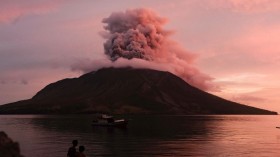A new study published in the journal Nature reveals the strongest evidence yet that short-duration gamma ray bursts (GRBs) are produced by the merger of super-dense neutron stars locked in a binary system.
Neutron stars are small, measuring an estimated 20 kilometers in diameter, but are so dense that one teaspoonful would weigh 1 billion tons on Earth. GRBs, on the other hand, are mysterious flashes of intense high-energy radiation that appear from random directions in space.
Short-duration GRBs last a few seconds at most, but are sometimes accompanied by afterglows that continue for several hours and even days, allowing astronomers over the years to trace them back to their source in distant galaxies.
However, despite being able to identify their origins, scientists could only speculate regarding their birth, though most predicted them to be the offspring of the resulting collision when two neutron stars in a binary system spiral together.
This occurs as the system emits gravitational radiation, creating tiny waves in the fabric of space-time. The energy dissipated by the waves causes the two stars to sweep closer together and, in the final milliseconds before the explosion, the two stars merge into a death spiral, kicking out highly radioactive material that then heats up and expands, emitting a burst of light.
Meanwhile, scientists have long speculated regarding the existence of an intense cosmic event called a kilonova, or explosion 1,000 times stronger than a supernova.
In a recent science paper, Jennifer Barnes and Daniel Kasen of the University of California at Berkeley and the Lawrence Berkeley National Laboratory presented new calculations predicting how kilonovas might look. In it, they hypothesized that the same hot plasma producing the radiation also will block the visible light, causing the gusher of energy from the kilonova to flood out in near-infrared light over several days.
As it turned out, an unexpected opportunity to test this model came on June 3 when NASA' s Swift space telescope picked up the extremely bright GRB 130603B. Although the initial GRB lasted just one-tenth of a second, it was roughly 100 billion times brighter than the subsequent kilonova flash.
Between June 12 and 13, Hubble searched the location of the initial burst, spotting a faint red object. Subsequent Hubble observations on July 3 further revealed the source had faded away, thus providing the key evidence needed to prove that the infrared glow was from an explosion accompanying the merger of two objects.
While scientists predicted that a kilonova accompanies a short-duration GRB, this moment marked the first time anyone had ever seen this happen.
"This observation finally solves the mystery of the origin of short gamma ray bursts," said Nial Tanvir of the University of Leicester in the United States. Tanvir led a team of researchers using Hubble to study the recent short-duration GRB.
"Many astronomers, including our group, have already provided a great deal of evidence that long-duration gamma ray bursts (those lasting more than two seconds) are produced by the collapse of extremely massive stars. But we only had weak circumstantial evidence that short bursts were produced by the merger of compact objects," he explained. "This result now appears to provide definitive proof supporting that scenario."
© 2024 NatureWorldNews.com All rights reserved. Do not reproduce without permission.

![Extreme Heat Wave in Africa’s Sahel Region That Killed 100 People Linked to Climate Change [Study]](https://1471793142.rsc.cdn77.org/data/thumbs/full/70226/280/157/50/40/extreme-heat-wave-in-africa-s-sahel-region-that-killed-100-people-linked-to-climate-change-study.jpg)



